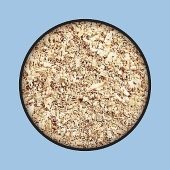





 1
1








 2
2




Make sure that your worms have plenty of depth to hide in/eat in if the fresh chicken manure is too ammoniacal for them. Also, try adding layers of newspaper on top of the worm farm every couple of days, or at least once a week so the layers of manure have an opportunity to mature before they get to where the worms are.
I would recommend you look into cultivating some oyster mushrooms in straw and using the cultured straw as a layer instead of the newspaper (or culture the newspaper or use cultured cardboard instead.) Oyster mushrooms are particularly easy to cultivate and they will add an extra level of processing the chicken manure so that it will be easier on your worms. Mushroom cultivation is beyond the scope of this post, but for more information I'd recommend 'Growing Gourmet and Medicinal Mushrooms' by Paul Stamets for all you need to know, and more. If you just need a mycocultured substrate to use you could either use spent substrate or not even worry about processing for harvesting – just get the mycelium going and dump a layer of substrate where the manure falls.
Lastly, I'd recommend two things in your worm farm design:
1) A space which is large enough for your worms to live where no chicken manure will reach. This way if the manure section is uninhabitable, the worms will hang out in a different area and they will be safe. You could even consider making a rotating design – once every 6 months, shift the worm farm so that the older manure is the 'safe zone', and the new manure falls on the old 'safe zone'
2) If possible, create a zone where the worm farm occupies space within the chicken run, and make it quite a lot shallower than the rest of your worm farm. This way your chickens will occasionally harvest the stray worm who venture into the chicken run zone. If your worm population explodes, I would expect that there would be an abundance of worms in the shallow end which your chickens have access to – and they will soon figure out that this is the best area for finding worms. Free protein feed for your chickens and free population control for your worms!





The chickens would have an enclosed outside run about 8 feet by 12 feet and would be occasionally tractored in the garden. This is for a Portland, Oregon city lot 50 x 100 feet.
Hans Albert Quistorff, LMT projects on permies Hans Massage Qberry Farm magnet therapy gmail hquistorff




















It's time to get positive about negative thinking  -Art Donnelly
-Art Donnelly











nancy sutton wrote:Kevin, Justin Rhodes (The Permaculture Chicken Guy) said that in his chicken tractor, the wire floor has to have a minimum 1" grid to allow manure to fall through. Maybe the weather affects the rate of drying, making for smaller chicken droppings. He's in No Carolina.
Hans Albert Quistorff, LMT projects on permies Hans Massage Qberry Farm magnet therapy gmail hquistorff




This is all just my opinion based on a flawed memory









 1
1











 2
2




Hans Albert Quistorff, LMT projects on permies Hans Massage Qberry Farm magnet therapy gmail hquistorff

|
Yeah, but does being a ninja come with a dental plan? And what about this tiny ad?
2024 Permaculture Adventure Bundle (now a special for october 2025)
https://permies.com/w/bundle
|







